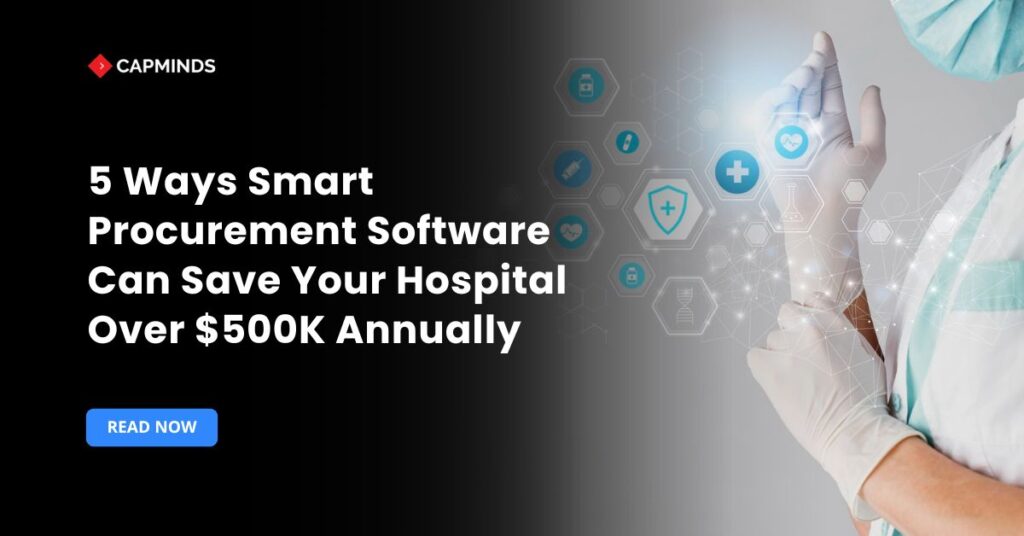5 Ways Smart Procurement Software Can Save Your Hospital Over $500K Annually
Hospital supply chains eat up nearly 40% of operational budgets. When these systems break down, profit margins disappear fast. Recent research reveals a troubling reality. Almost 30% of hospital supply spending goes to waste. Poor inventory tracking and inadequate planning drive most of this loss.
Hospital procurement software addresses these pain points directly. It removes manual bottlenecks. It brings clarity to complex supply networks.
Effective inventory management helps keep costs in check. Contract enforcement protects negotiated rates. Supplier consolidation increases buying power. Demand forecasting prevents overstocking.
Workflow automation cuts processing time. These improvements slash both direct supply costs and hidden waste. Many hospitals report savings of hundreds of thousands annually. Here are five proven ways procurement systems deliver real cost reductions.
1. Optimize Inventory Management
Smart inventory control ensures you have enough supplies on hand, but not too many. Automated real-time tracking and reorder alerts let you adopt just-in-time purchasing, which reduces expensive stockpiles. This can cut inventory holding costs by up to 40%. Key benefits include:
- Reduce excess stock and waste: Software flags low-turn items before they expire, preventing costly disposals. Hospitals typically waste ~30% of supply spending due to overstock and poor tracking. By matching reorders to actual usage, smart systems shrink this waste.
- Prevent stockouts and backorders: With dashboard visibility across departments, staff know exactly what’s on hand. This avoids the high indirect costs of last-minute rush orders or canceled procedures. Remember, 40% of hospitals have canceled surgeries due to a lack of supplies. Continuous tracking also frees up finance by reducing unplanned urgent purchases.
- Consolidate multi-site inventory: Integrated systems let you pool supplies across facilities. Rather than each department hoarding, you share inventory data to pool resources and order in bulk, improving utilization.
By tightening inventory levels and avoiding emergency buys, hospitals save on both direct costs (less capital tied up in inventory) and indirect costs (fewer wasted supplies and schedule delays).
Related: The Enterprise Guide to Digitizing Inventory and Procurement in 2025
2. Enforce Contract Compliance
Uncontrolled spending on non-contract items is a hidden leak. Procurement software automatically checks every order against approved contracts and GPO agreements. This ensures the hospital always buys at negotiated rates. Key points:
- Mandatory contract checks: The system flags any off-contract item, forcing users to choose approved vendors. Centralized contract repositories and audit trails enforce purchasing policies.
- Maximize negotiated discounts: By integrating Group Purchasing Organization (GPO) price lists, hospitals automatically get the best rates for high-volume items. This eliminates missed savings on routine supplies.
- Maverick spend control: Automated workflows prevent “rogue” purchases outside the policy. With better oversight, organizations see contract compliance jump dramatically, often above 90%.
Improving compliance turns known negotiated prices into actual savings.
For example, automating contract enforcement has been shown to boost compliance to ~95%, locking in those discounts across every purchase. This not only lowers direct procurement costs but also reduces audit findings and financial risk.
3. Streamline Supplier Consolidation
Fewer, stronger vendor relationships drive better pricing and service. Procurement platforms make it easy to standardize on preferred suppliers and eliminate redundancy. Benefits include:
- Volume discounts: Consolidating orders to a limited supplier list increases volume with each vendor. In practice, hospitals using fewer strategic suppliers negotiate better bulk pricing and rebates.
- Lower administration overhead: With fewer vendors, finance and purchasing teams process fewer purchase orders and invoices. This cuts transactional labor and reduces billing errors.
- Improved supplier performance: Centralized data lets you track each supplier’s delivery times, prices, and quality. Underperforming vendors are flagged sooner, ensuring you only pay premium prices for high-service partners.
- Integrated GPO leverage: Software can tap into national GPO contracts, automatically comparing prices. This guarantees you never miss a better deal and simplifies multi-vendor management.
Supplier fragmentation is a known cost driver in healthcare. By rationalizing your vendor base and driving spend through top suppliers, hospitals achieve significant cost avoidance and improved terms, compounding savings from better inventory and contract management.
4. Improve Demand Forecasting
Advanced systems use data analytics and technology to predict what supplies you’ll need. This reduces waste and rush costs. Instead of reacting to shortages, hospitals plan their inventory around expected demand. Key features include:
- Analytics-driven purchasing: The software analyzes historical usage and seasonal trends. It even looks at patient data to forecast needs. Your order becomes closer to the real need. This prevents overstock of slow-moving items. Hospitals using forecasting can cut supply waste by up to 50%.
- Just-in-time ordering: With accurate forecasts, stock gets replenished only when needed. This minimizes storage costs and spoilage. Excess inventory gets avoided, especially perishable medical goods.
- Fewer emergency orders: By foreseeing busy periods, you avoid paying premium prices. No more overnight or last-minute deliveries. This directly reduces procurement expenses. It also stabilizes budgets.
Demand forecasting leads to better budget planning. Decision-makers can set more realistic supply budgets. They avoid surprise spending peaks.
Accurate forecasting shrinks both direct purchase costs and indirect costs. This includes overtime fees or expedited shipping. The overall savings multiply.
Related: Top Hospital Procurement KPIs You Can’t Track Without the Right System
5. Automate the Procure-to-Pay Process
Workflow automation saves hospitals serious time and money. Paper-based purchasing systems waste countless hours every day. Digital systems cut through this mess.
Hospital staff spend too much time on paperwork. Purchase orders get lost in email chains. Invoice approvals take weeks to process. Manual data entry creates constant errors.
Automated systems fix these problems fast.
Electronic Orders Work Better
- Staff enter what they need into the system. The software creates purchase orders automatically. It sends approvals to the right people. It updates inventory when items arrive.
- This process cuts cycle times by about 40%. No more chasing down signatures or lost forms.
Invoice Processing Gets Faster
- Workflow automation saves hospitals serious time and money. Paper-based purchasing systems waste countless hours every day. Digital systems cut through this mess.
- Hospital staff spend too much time on paperwork. Purchase orders get lost in email chains. Invoice approvals take weeks to process. Manual data entry creates constant errors. Automated systems fix these problems fast.
Electronic Orders Work Better
- Staff enter what they need into the system. The software creates purchase orders automatically. It sends approvals to the right people. It updates inventory when items arrive.
- This process cuts cycle times by about 40%. No more chasing down signatures or lost forms.
Invoice Processing Gets Faster
- The system matches invoices to purchase orders instantly. It compares receipts to what was ordered. Duplicate payments become impossible. Late payment penalties disappear.
- Hospitals using automated invoice processing report 60-80% faster turnaround times. Finance teams handle more volume with fewer people.
Errors Drop Dramatically
- Standardized data entry prevents most mistakes. The system logs every transaction. Finance teams spend less time fixing problems. Reconciliations happen automatically.
- Audit trails show exactly what happened and when. Compliance becomes much easier.
Staff Focus on What Matters
- Nurses and administrators waste 60% of their time on paperwork. Automation gives them this time back. They can focus on patient care instead of purchase orders.
- Procurement teams handle strategic tasks rather than data entry. Finance staff analyze spending patterns instead of chasing invoices.
Better Control Over Spending
- Digital workflows provide complete visibility. Managers see spending patterns in real-time. Approvals happen faster with clear rules. Payment cycles shrink significantly.
- The hospital saves thousands of labor hours annually. Indirect costs from manual processes drop sharply. Staff productivity jumps across departments.
Related: The CIO’s Blueprint for Modernizing Inventory & Procurement in 2025
Unlock Sustainable Hospital Savings with CapMinds Smart Supply Chain Solutions
At CapMinds, we understand that modern hospitals need more than just cost control; they need intelligent systems that prevent waste before it happens.
Our end-to-end Digital Health Tech Solutions empower hospitals to optimize operations and unlock savings of over $500K annually with smart procurement strategies.
We help you turn procurement into a strategic advantage with:
- Hospital Procurement Software that enforces contract compliance and curbs maverick spend
- Inventory Management Systems that reduce stockouts, eliminate overstock, and optimize reorders
- Smart Supply Chain Solutions for vendor consolidation, demand forecasting, and JIT purchasing
- Automated Procure-to-Pay Platforms that slash admin costs and reduce invoice errors
Whether you’re running a multi-site health system or a specialty hospital, CapMinds delivers scalable, secure, and fully customized platforms built for healthcare. Ready to take control of your hospital’s supply chain and savings?
Get in touch with CapMinds today to modernize your procurement and power long-term growth.




